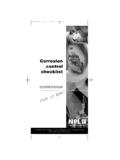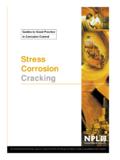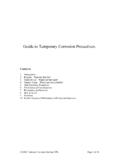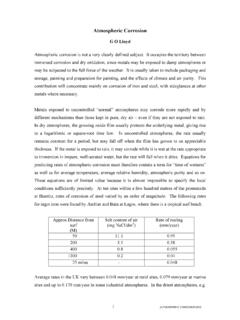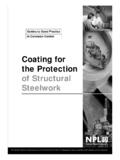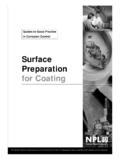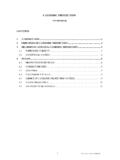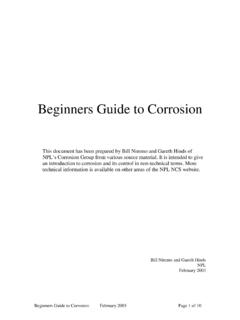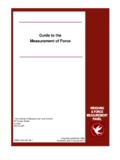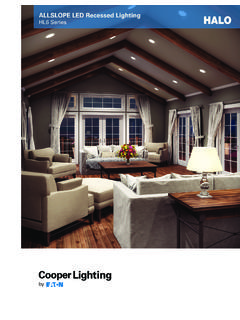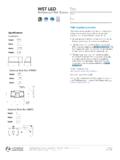Transcription of A Guide to the Specification of LED Lighting …
1 A Guide to the Specification of LED Lighting Products2012 October 2012 Highway Electrical AssociationProfessional Lighting Designers AssociationSociety of Light and LightingInstitution of Lighting ProfessionalsInternational Association of Lighting DesignersThis Guide has been produced under the umbrella of the Lighting Industry Liaison Group and is endorsed by its member organisations: Lighting Industry AssociationSummaryTypical questions a user should ask are shown below. More detail is given in further sections of this Performance IndicationsEvidence requiredHow is life defined?By a combination of lumen maintenance and failure should always be stated as: 1. Light Loss - Usually either L90 or L70 (L50 for decorative luminaires) no. of hours; and2. Physical Failures - LED Life F10 no. of hours If the rated life of a product is 50,000 hours, this means light loss of L70 and physical failures of Fx (where x is the percentage no.)
2 Of failures) at the rated life of 50,000 hours. (Note: it should be assumed that the manufacturer has tested to a maximum of 6000 hrs and extrapolated beyond that unless they explicitly state differently)See section is the lumen depreciation?Rate and percentage of light lossLight output > 90% of initial Code 9 Light output > 80% of initial Code 8 Light output > 70% of initial Code 7 See section 3hWhat is the colour rendering index?The rated CRI should include any shift over CRI and CRI section 3fHow stable is the Colour temperature?Defined by the initialcolour variation & colour variation through lifeWithin a 1-step ellipseWithin a 3-step ellipseWithin a 5-step ellipseWithin a 7-step ellipseGreater than a 7-step ellipseSee section 3gWhat ambient temperature is the luminaire performance based on?For indoor 250C for outdoor 150 What is the photometric distribution?
3 Measurement of the light intensities at various angles in absolute unitsCandelas (cd) and degreesSee section 3nDriver currentThe current at which the LED s are drivenMeasured in mAPower FactorThe power factor for the whole or IntroductionThe rise of LED Lighting is driving a significant transformation of the Lighting industry. LEDs can provide a palette of millions of colors and dynamic effects that conventional Lighting cannot match in terms of design, scene-setting and ambience. Thanks to their miniaturized dimensions and low heat radiation, they can be embedded almost anywhere. And being digital, they are programmable, offering unlimited scope for creative use and effective management. They offer long lifetimes, energy and maintenance savings, making them potentially an efficient solution. This is the fourth edition of the guidance notes produced under the umbrella of the Lighting Liaison Group, which is an informal group representing the major Lighting organisations in the UK who have endorsed and added their names to this Guidelines document.
4 They introduce a universal set of quality criteria from the IEC/PAS documents. As a user of LED luminaires it is important to apply the same set of standardised quality criteria when evaluating manufacturer s claims. Users of LED luminaires should always ask for LED luminaire specifications measured in compliance with the new IEC/PAS documents. This will allow all interested parties to judge comparison claims on an equal, like-for-like basis serving the interests of end-users, specifiers, designers and manufacturers. The following terms are used in the guidance document:LED Die -The LED die (or chip) is the funamental light Package -The LED die is contained in a suitable package allowing simplified electrical connection or assembly. LED Module -This is the LED together with mechanical and optical components making a replaceable item for use in a Luminaire -This is the complete system consisting of all elements described in Section 1.
5 System ReliabilityMost quality criteria are linked to the initial performance requirements of LED modules and LED luminaires. For maintained values 25% of rated life time up to a maximum of hours is used. There is no measurement of lifetime above hours. Accelerated test methods providing more advanced insight in lumen depreciation over LED module and/or LED luminaire life are under consideration. However it is important to keep in mind that lifetime claims based on lumen maintenance and luminaire life are two very different things. The lifetime claims based on lumen maintenance refers to the lumen maintenance projections of the LED light sources integrated into that luminaire. Lifetime claims based on luminaire life relate to physical many LED luminaire manufacturers use test results provided by LM-80 (IES LM-80-08.)
6 Approved Method: Measuring Lumen Maintenance of LED-Light Sources Illuminating Engineering Society of North America, consists of a real measurement over the first 6000 hours combined (with an extrapolation out to end of life) as the L90, L70 and L50 lumen maintenance thresholds of LED luminaires. But there is a disconnection between the LM-80 test results made by the LED die manufacturer and the results from the LED luminaire where, for example, issues such as thermal management can change the actual performance. LM-80 requires testing of LED light sources for 6.,000 hours, and recommends testing for 10.,000 hours. It calls for testing at three surface temperatures (55 C, 85 C, and a third temperature to be determined by the manufacturer) so that users can see the effects of temperature on light output, and it specifies additional test conditions to ensure consistent and comparable results.
7 In practice, leading LED light source manufacturers test their products to the LM-80 minima of or hours, and then apply extrapolation methodologies as described in TM-21 (IES TM-21-11. Projecting Long Term Lumen Maintenance of LED Packages Illuminating Engineering Society of North America, 2011) to arrive at L90, L70 and L50 figures. Luminaire manufacturers translate these curves into LED luminaire specific curves. There are two constraints in translating these test results into LED luminaire performance. First catastrophic failures of individual LEDs and other failure modes of light output depreciation are not taken into consideration. Second there is no validated way to translate the lumen maintenance curve of an individual LED-light source into a curve for the LED-luminaire. Luminaire life, on the other hand, has to do with the reliability of the components of a LED luminaire as a system.
8 Factors affecting the system performance are:LEDs -While LEDs do not radiate heat, with current products half or more of the input energy may be converted to heat that must be conducted away from the -LEDs are directional light sources, giving the lamp or luminaire designer new challenges when compared to existing lamp technology. The use of reflectors, lenses and diffusers allows a designer to direct light in many different ways. The efficiency and depreciation of the optical system must be considered and factored into the overall efficiency of the sSystem ReliabilityCooling Quality CriteriaThe IEC published two Public Available Specification (PAS) performance requirement documents dealing with LED products. IEC/PAS 62717 Performance requirements LED modules for general Lighting IEC/PAS 62722 Performance requirements LED luminaires for general Lighting These were developed together to provide: the definition of a set of quality criteria related to the initial specifications of a product ; a standardised description on how to measure these quality criteria.
9 To ensure consistency in quality criteria, definitions and measuring methods, most of these are defined in IEC/PAS 62717. The luminaire standard IEC/PAS 62722 under certain conditions allows the use of compliant modules to reduce the number of tests for LED luminaires. This makes manufacturers claims of initial specifications of LED- modules and luminaires comparable. The following list of quality criteria should be considered when evaluating manufacturer s claims: a) Rated input power -The rated input power shows the amount of energy consumed by a luminaire, including its power supply. It is expressed in watts. b) Rated luminous flux -This is the light emitted by the luminaire which is expressed in lumens. For traditional (non LED) luminaires it is usual that Relative values are measured and multiplied by the lamp flux. For LED luminaires it is recommended that Absolute photometric values are used.
10 Absolute photometry results in a LOR= ) LED luminaire efficacy -The measured initial luminous flux divided by the measured initial input power of the same individual LED luminaire. It is expressed in lumens per watt. d) Luminous intensity distribution -The spatial distribution of the luminous flux graphically depicted in a luminous intensity distribution curve, which is usually expressed in a polar diagram representing the light intensity as a function of angle about a light source. It is expressed in -The mechanical integrity of a luminaire is important in several different areas including: IP rating to suit the application, heat-sinking that will not become compromised with time, lack of maintenance, vibration resistance so the heat-sink does not become detached from the PCB, bonding mechanisms that are suitable for the life of the luminaire.
